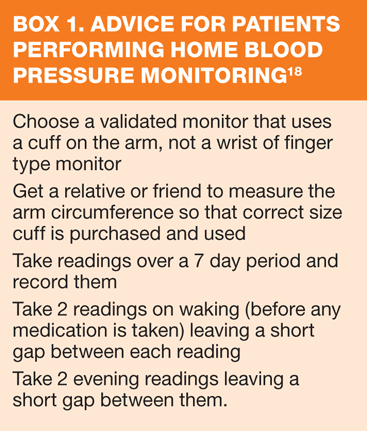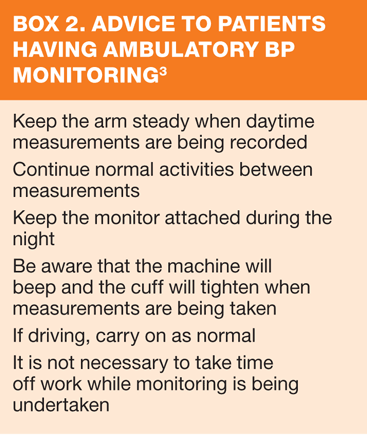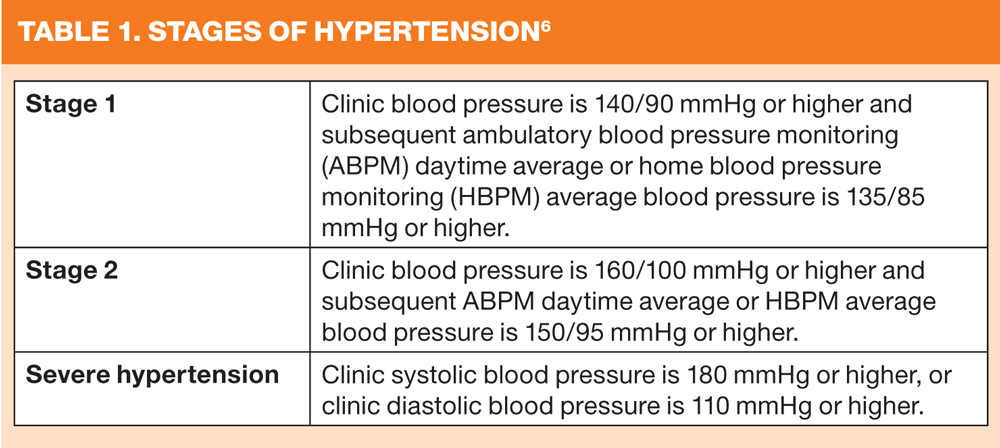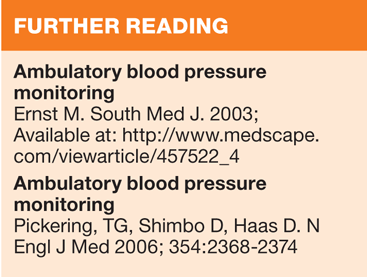Overcoming white coat hypertension with ambulatory blood pressure monitoring
Margaret Perry
Margaret Perry
RGN BSc(Hons) MSC
Advanced nurse practitioner, West Bromwich
With greater awareness of the potential for 'white coat' hypertension, the gold standard for the diagnosis of high blood pressure is now considered to be ambulatory blood pressure monitoring. Margaret Perry explains the rationale and provides practical advice
It is estimated that around 33% of men and 25% of women aged 45- 54 years have diagnosed hypertension, increasing with age to 73% of men and 64% of women aged 75 years or older.1 However, of particular concern is the possibility that there are many more people who remain undiagnosed and therefore untreated, increasing their risk of heart attack or stroke, and premature mortality. This article gives an overview of important recent changes to the way in which hypertension is detected and hopes to enhance practice nurses knowledge and enable them to incorporate these changes into their daily practice, hence improving the quality of care given to their patients.
WHY THE NEED FOR CHANGE?
In the past detection and assessment of patients with suspected raised blood pressure involved repeated measurements over a period of time, often with a gap of two to three weeks between them, to establish consistently raised readings.2 Concerns relating to possible inaccuracies in measurements with the old style sphygmomanometers led to a change to the use of automated devices.3 However, concerns remained that these readings might still be inaccurate and ambulatory blood pressure monitoring (APBM) is now regarded as the gold standard for diagnosis of hypertension.4
THE 'WHITE COAT' EFFECT
White coat hypertension is defined as the occurrence of blood pressure (BP) values higher than normal when measured in the medical environment, but within the normal range during daily life: 'normal' is usually defined as average daytime or home BP values of below 135 mmHg systolic and less than 85mmHg diastolic. One of the concerns is that patients who fall into this category may be misdiagnosed as hypertensive and treated with medications that they do not need. This is not something that affects only the occasional patient — it is estimated that around 15-30% of people experience white coat hypertension,5 and it can occur in both those on antihypertensive treatment and those who are not.
AMBULATORY BLOOD PRESSURE MONITORING
NICE recommends that a diagnosis of primary hypertension should be confirmed using 24 hour ABPM or, if not acceptable to the patient, home blood pressure monitoring rather than relying on isolated blood pressure readings taken in the clinic setting.6 Patients who may benefit from ambulatory monitoring include:
- Suspected white coat hypertension
- Newly found hypertension during pregnancy
- Patients with co morbid conditions such as diabetes, or cerebrovascular disease
In addition, ABPM is recommended for the evaluation of response to treatment or to resistance to treatment.
HOME BLOOD PRESSURE MONITORING
Home blood pressure monitoring (HBPM) is suggested as an alternative to ABPM but it is thought to be inferior, in that it does not provide information relating to nocturnal blood pressures and gives fewer readings, whereas ABPM provides a higher number of BP measurements scattered over a longer period of time, which may include periods of stress, rest and work, therefore giving a more reliable estimate of random BP variability.7
However, it may be useful when ABPM is poorly tolerated, inconvenient for the patient or if the patient refuses ABPM. Home monitoring may also be used to assess BP control in patients with significant white coat hypertension.
Method
When HBPM is the preferred method readings should be taken twice daily (preferably morning and evening) for at least seven days. For each reading, two consecutive measurements should be taken at least one minute apart with the person seated.6 The measurements from the first day should be discarded before the average value of the readings is calculated to confirm a diagnosis of hypertension. Guidance for patients who are asked to use this method or who choose to do so, is shown in box 1.
BENEFITS OF ABPM
Blood pressure usually falls at night, and a 10% decrease during sleep is considered normal. People whose BP drops overnight are known as 'dippers'.8 Those whose blood pressure remains elevated during sleep (non-dippers) have been found to have a higher prevalence of left ventricular hypertrophy, albuminuria, and peripheral arterial changes, than dippers.9 They are also thought to be at greater risk of cardiovascular mortality than dippers.10 ABPM is thought to be superior to clinic blood pressures because there is evidence to suggest that whole day BP measurement is a more accurate predictor of target organ damage in hypertension than isolated clinic blood pressure readings.11
Contraindications
There are no specific contraindications but measurements may be less accurate in patients with cardiac arrhythmias.12
Adverse effects
Although ABPM is generally well tolerated, interference with sleep has been reported.13 Other reported adverse physical effects include pain and skin irritation and less frequently, bruising.14
IMPLEMENTING ABPM
Various monitors are available for purchase and factors affecting choice may include cost of the equipment, ease of use, compatibility with computer systems and whether or not training is available from the manufacturer. The selected monitor should also meet the standards expected by the British Hypertension Society.15
Fitting the monitor
Approximately 30 minutes should be scheduled for the fitting appointment, to allow time adequate explanation and time for questions, before obtaining informed consent and fitting. Before the monitor is fitted, measure BP manually in both arms: if the systolic measurement is greater than 10mmHg in one arm, the arm with the higher pressure should be used.16 Ensure that an appropriate cuff size is selected because a cuff which is one size too large will underestimate systolic and diastolic BP readings by 3-5 mmHg in men and 1-3mmHg in women, and overestimate by 2-6mmHg in men and 3-4mmHg in women when the cuff is one size too small.16 The meter is then fitted to the patient. The digital machine takes blood pressure readings by inflating the cuff around the upper arm in the same way a meter records blood pressure in surgery. The recording device is attached to a belt or waistband. Both remain in place for the full 24 hours. The machine then takes blood pressure readings at regular intervals throughout the day (and night), usually every 20—30 minutes, although it can usually be set to record at different time intervals if required.17 During waking hours, the patient should continue their normal daily activities. At night the meter can be placed close by, either on the bedclothes or on the pillow. After 24 hours the patient returns, and both cuff and meter are removed. The meter is then connected to the computer and a report is generated. The way in which readings are displayed varies according to the type of machine being used and may be shown numerically or as a graph or both. Measurements for systolic and diastolic blood pressures are shown for the times they have been recorded with mean values.
INTERPRETATION OF RESULTS
NICE states that antihypertensive treatment should be offered to all patients under 80 years with an initial clinic blood pressure of 140/90mmHg or higher and a subsequent ABPM daytime average 135/85 mmHg or higher, who have one or more of the following:
- Target organ damage
- Established cardiovascular disease
- Renal disease
- Diabetes
- A 10-year cardiovascular risk equivalent to 20% or greater6
Antihypertensive treatment should also be offered to people of any age with an initial clinic systolic blood pressure which exceeds 160mmHg and/or diastolic blood pressure greater than 100mmHg and a subsequent ABPM daytime average or HBPM average of 150/95mmHg or higher.6 Further investigation and referral to a specialist may be needed for younger patients (below 40 years of age) who have no known co-morbidities and no evidence of target organ damage to exclude any other cause of their elevated readings. This is recommended because 10-year cardiovascular risk assessments can underestimate the lifetime risk of cardiovascular events in these people.64
CONCLUSION
Ambulatory blood pressure has been shown to have a number of benefits for the diagnosis of hypertension and has few side effects or contraindications. Its use can help to reduce unnecessary prescribing and hence prescribing costs, and to improve patient care. As more practices implement ambulatory monitoring and gain experience of the technique, practice nurses will become confident in selecting the patients who would benefit from ABPM, ensuring that treatment is provided where it is needed, and not wasted where it is not.
REFERENCES
1. British Heart Foundation. Coronary heart disease statistics. BHF, 2012. http://www.bhf.org.uk/research/statistics/risk-factors/blood-pressure.aspx
2. O'Brien E. Use and interpretation of ambulatory blood pressure monitoring. BMJ. 2000; 320 (7242): 1128-1134.
3. Pickering TG, James GD, Boddie C, et al. How common is white coat hypertension? JAMA. 1988; 259: 225-228
4. Hodgkinson J, Mant J, Martin U, et al. Relative effectiveness of clinic and home blood pressure monitoring compared with ambulatory blood pressure monitoring in diagnosis of hypertension: systematic review. BMJ 2011;342:d3621
5. Celis H, Fagard RH. White-coat hypertension: a clinical review. Eur J Intern Med. 2004 Oct;15(6):348-357
6. NICE. Hypertension: clinical management of primary hypertension in adults (CG127). 2011. Available at: http://www.nice.org.uk/guidance/CG127
7. Verdecchia P, Angeli F, Mazzotta G, et al. Controversies in Hypertension: Home blood pressure measurements will not replace 24-hour ambulatory blood pressure monitoring. Hypertension. 2009; 54: 188-195.
8.Verdecchia P, Schillaci G, Porcellati C. Dippers versus non-dippers. J Hypertens 1991; 9( Suppl 8): S42-S44.
9. Redon J, Liao Y, Lozano JV, Miralles A, Pascual JM, Cooper RS. Ambulatory blood pressure and microalbuminuria in essential hypertension: Role of circadian variability. J Hypertens 1994; 12: 947-953.
10. Ohkubo T, Imai Y, Tsuji I, Nagai K, Watanabe N, Minami N, et al. Relation between nocturnal decline in blood pressure and mortality: The Ohasama Study. Am J Hypertens 1997;
10: 1201-1207.
11. Mancia G, Zanchetti A, Agabiti Rosei E et al for the SAMPLE Study Group. Ambulatory blood pressure is superior to clinic blood pressure in predicting treatment induced regression of left ventricular hypertrophy. Circulation 1997; 95: 1464—70.
12. Mcgrath BP. Ambulatory blood pressure monitoring. Med J Aust. 2002;176:588—92.
13. Van der Steen MS, Lenders JW, Thien T: Side effects of ambulatory blood pressure monitoring. Blood Press Monit 2005, 10:151-155
14. Viera AJ, Lingley K, Hinderliter AL. Tolerability of the Oscar 2 ambulatory blood pressure monitor among research participants: a cross-sectional repeated measures study. BMC Medical Research Methodology 2011, 11:59
15. O'Brien E, Petrie J, Littler WA, et al. The British Hypertension Society protocol for the evaluation of blood pressure measuring devices. J Hypertens 1993; 11: S43- S63.
16. Sprafka JM, Strickland D, Gomez-Marin O, et al. The effect of cuff size on blood pressure measurement in adults. Epidemiology. 1991; 2(3):214-7.
17. National Heart Foundation and High Blood Pressure Research Council of Australia Ambulatory Blood Pressure Monitoring Consensus Committee. Ambulatory blood pressure monitoring. Australian Family Physician. 2011; 40 (11): 877-880.
18. Blood pressure UK. How to use a blood pressure monitor. Available at: http://www.bloodpressureuk.org/BloodPressureandyou/Homemonitoring/Howtomeasure
Related articles
View all Articles



